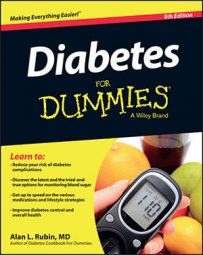Hypoglycemia results from elevated amounts of insulin driving down your blood glucose to low levels, but an extra high dose of insulin or sulfonylurea medication isn't always the culprit. Your blood glucose level is also affected by the amount of food you take in, the amount of fuel (glucose) that you burn for energy, the amount of insulin circulating in your body, and your body's ability to raise glucose by releasing it from the liver or making it from other bodily substances.
On average, hypoglycemia in people with type 1 diabetes causes noticeable symptoms only about twice a week and is severe perhaps once a year. In people with type 2 diabetes, severe hypoglycemia occurs only one-tenth as often. (The medications described in the next section are part of the reason that people with type 1 diabetes have to deal with hypoglycemia more often.) The following sections cover the causes of hypoglycemia and the ways you can manage those factors to keep your blood glucose level in check.
Insulin and sulfonylurea medications
All people with type 1 diabetes (and some with type 2) rely on insulin injections to control the disease. When you take insulin shots, you have to time your food intake to raise your blood glucose as the insulin is taking effect. But remember that the different types of insulin are most potent at differing amounts of time (minutes or hours) after you inject them. If you skip a meal or take your insulin too early or too late, your glucose and insulin levels won't be in sync and you'll develop hypoglycemia. If you go on a diet and don't adjust your medication, the same thing happens.
If you take sulfonylurea drugs, you need to follow similar restrictions. You and your doctor must adjust your dosage when your calorie intake falls. Other drugs don't cause hypoglycemia by themselves, but when combined with sulfonylureas they may lower your glucose enough to reach hypoglycemic levels.
Diet
Your diet plays a major role in helping you avoid hypoglycemia if you take medication. You should try to have a snack in the middle of the morning and in the afternoon — in addition to your usual breakfast, lunch, and dinner — especially if you take insulin. A properly timed snack provides you with a steady source of glucose to balance the insulin that you're taking.
You can use your blood glucose level to determine whether to have a snack at bedtime. If your glucose is greater than 180 mg/dL (10 mmol/L), you probably don't need a snack. If your glucose is between 126 and 180 mg/dL (7 to 10 mmol/L), a couple slices of bread and an ounce of cheese will prevent hypoglycemia. If your glucose is less than 126 mg/dL (7 mmol/L), a couple ounces of meat plus a slice of bread will do the trick.
Exercise
Exercise burns your body's fuel, which is glucose, so it generally lowers your blood glucose level. Some people with diabetes use exercise in place of extra insulin to get their high blood glucose down to a normal level. But if you don't adjust your insulin dose or food intake to match your exercise level, exercise can result in hypoglycemia.
Nondiabetes drugs
Several drugs that you may take unrelated to your diabetes can lower your blood glucose. One of the most widely used, which you may not even think of as a drug, is alcohol, which can block your liver's ability to release glucose. It also blocks hormones that raise blood glucose and increases the glucose-lowering effect of insulin. If you're malnourished or you simply haven't eaten in a while and you drink alcohol before going to bed, you may experience severe fasting hypoglycemia the next morning. If you take insulin or sulfonylurea drugs, don't drink alcohol without eating some food at the same time. Food counteracts some of the glucose-lowering effects of alcohol.
Also, be aware that aspirin (and all of the drugs related to aspirin, called salicylates) can lead to hypoglycemia. In adults who have diabetes, aspirin can increase the effects of other drugs that you're taking to lower your blood glucose. In children with diabetes, aspirin has an especially profound effect on lowering blood glucose to hypoglycemia levels. However, the low dose of aspirin taken daily to reduce the risk of heart attacks does not cause hypoglycemia.
More than 160 drugs have been associated with severe hypoglycemia. Usually it is found in a person taking insulin or a drug that works by increasing the body's own insulin. Following are the major drugs that cause hypoglycemia:
Angiotensin-converting enzyme inhibitors: Blood pressure drugs, most of which end in -pril
Beta blockers: Blood pressure drugs, most of which end in -olol (which also block the warning symptoms of hypoglycemia)
Pentamidine: An antibiotic
Quinine: Used to treat malaria
Quinolones: A group of drugs that are antibiotics, most of which end in -floxacin
Hormonal changes
As type 1 diabetes progresses, your body produces fewer and fewer hormones that counteract insulin when hypoglycemia is present. This situation leads to more severe hypoglycemia later in type 1 diabetes, especially if you and your doctor don't adjust your insulin injections in response to your lower glucose levels. People with type 2 diabetes who take insulin also develop this loss of protective hormones.
These same hormones also play the role of giving you warning signs when your blood glucose drops, such as sweating, a rapid heartbeat, and anxiety, so you are prompted to eat. When the hormone levels drop, these warning signs don't occur, so you aren't signaled that you need to eat. This situation is called hypoglycemia unawareness. If hypoglycemia is avoided, however, the loss of the protective hormones and the development of hypoglycemia unawareness may be reversed.

